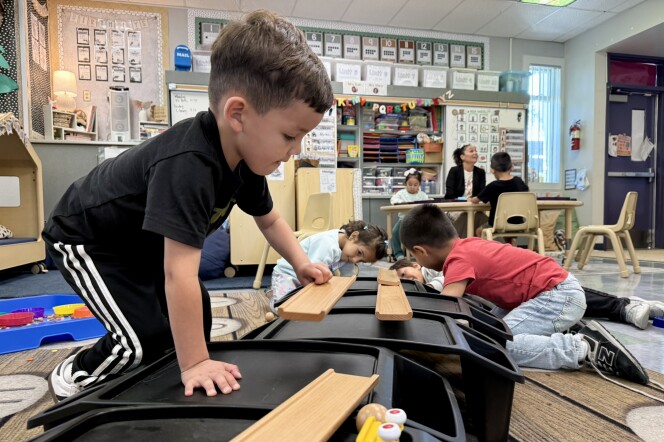With our free press under threat and federal funding for public media gone, your support matters more than ever. Help keep the LAist newsroom strong, become a monthly member or increase your support today.
Extracting DNA from Neanderthal urine — and other breakthrough technologies of the year
MARY LOUISE KELLY, HOST:
The ground beneath your feet might contain Neanderthal DNA, which scientists can now extract and analyze. The heart, beating in your chest, well, it could, if necessary, be swapped out for the heart of a pig. These are a couple of the 10 entries on this year's annual list of technological breakthroughs that's put out by the MIT Technology Review. And we are joined now by Amy Nordrum, who is executive editor of operations at the Review. Welcome.
AMY NORDRUM: Thanks. Good to be here.
KELLY: So much as I would love to get through all 10 of these, I'm going to try to zoom in on just a few of the ones that surprised me. And I will start with that Neanderthal DNA that I mentioned. Tell us about the emerging field of paleogenetics.
NORDRUM: Sure. This is a field of science that has really been growing for the last decade or so, and it's all about using ancient DNA to investigate early humans and related species and just help us better understand our origins. And what's really changed here, recently, is that scientists have become a lot better at processing and preparing ancient DNA to be analyzed. It makes it easier and more legible for sequencing machines, and they've created new kinds of machines that are more specialized for handling this kind of DNA, which can sometimes be really damaged. And they've gotten so good at this that they can now extract human DNA from samples of dirt just taken from archaeological sites. They don't even need a bone or a tooth to learn about the people who lived there.
KELLY: The detail that blew my mind is you can extract DNA from dirt that contains Neanderthal pee - urine. I mean, that's - it's mind-blowing.
NORDRUM: That's right. It's incredible. It's not just human DNA, either. Researchers have now been able to sequence DNA that was more than a million years old that came from a mammoth and also DNA from fish and plants that was more than 2 million years old.
KELLY: This is fascinating, in and of itself. But what might this tell us about ourselves, about humans today?
NORDRUM: Well, there's lots of things. Using these techniques, scientists have discovered two extinct species of humans that we didn't know existed before these techniques were available. And there's lots of things, as well, that it can tell us about early ecosystems. When we're learning about these ancient plants and animals that lived together, you can really get a picture of what an entire ecosystem looked like and also how it's evolved since that time.
KELLY: All right. Let's fast-forward right up to the present. Battery recycling - why does this make the list?
NORDRUM: Right. I mean, there's more demand than ever for batteries, and they're really critical to helping us achieve our climate goals. They let us store energy for use later, and they help convert things around fossil fuels, like cars, to be able to run on clean energy. But they're really dirty to produce, and we're going to need a lot more of them in the future. So if we're going to do that and really scale up, particularly in the case of electric vehicles, we need to start finding practical ways to recycle them. So there are several companies here in the U.S. that have really started to develop processes that allow them to separate out individual metals from old batteries because they contain lithium, as well as cobalt, copper and nickel. And they're now building pilot facilities throughout the U.S. to try and do this at scale.
KELLY: OK, let me turn now to the pig's heart. Now, this one is a bit more aspirational. However, there is now a man who survived for two months with a pig heart in his chest, opening the door to all kinds of possibility. What is going on in the world of organ transplants?
NORDRUM: That's right. We have a number of different types of methods that scientists are using to develop organs on our list this year, all rounded up into one category that we're calling organs on demand. And this is exciting because it's a big problem. The shortage of organs available for transplants is a major issue. There's people that die here in the U.S. and around the world every single day because they're on a waiting list and can't get an organ fast enough. And one way, as you said, to provide more organs to people is actually to grow them in animals. And there are several companies that are now raising pigs that have been gene edited to make their organs more compatible with humans so they aren't rejected by the immune system when they're implanted into a person.
There's other techniques out there, too. There are companies working on 3D printing organs, including lungs, kidneys, livers. And that's really hard for lots of reasons. One approach - one way of doing this is to kind of make a scaffold or an outline of an organ and then cover it in a patient's own cells to keep them from being rejected. And it's still really early days for those efforts. But some of these techniques are starting to get tested out in humans for the first time now.
KELLY: Amy Nordrum, executive editor of operations at the MIT Technology Review. And you can read the whole 2023 list of breakthrough technologies at technologyreview.com. Amy Nordrum, thanks.
NORDRUM: Thanks so much. Transcript provided by NPR, Copyright NPR.







